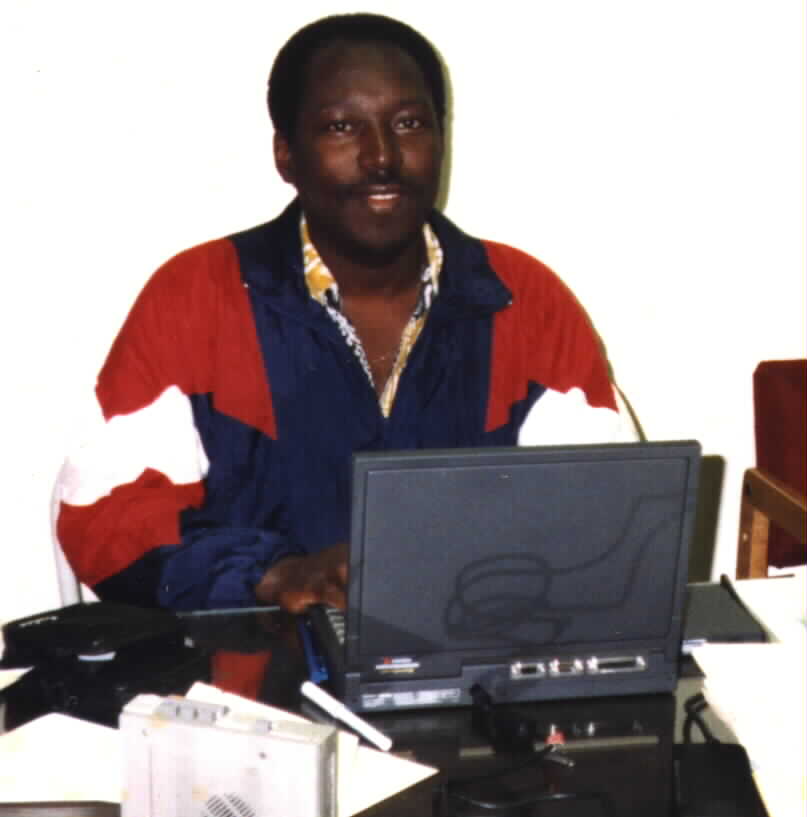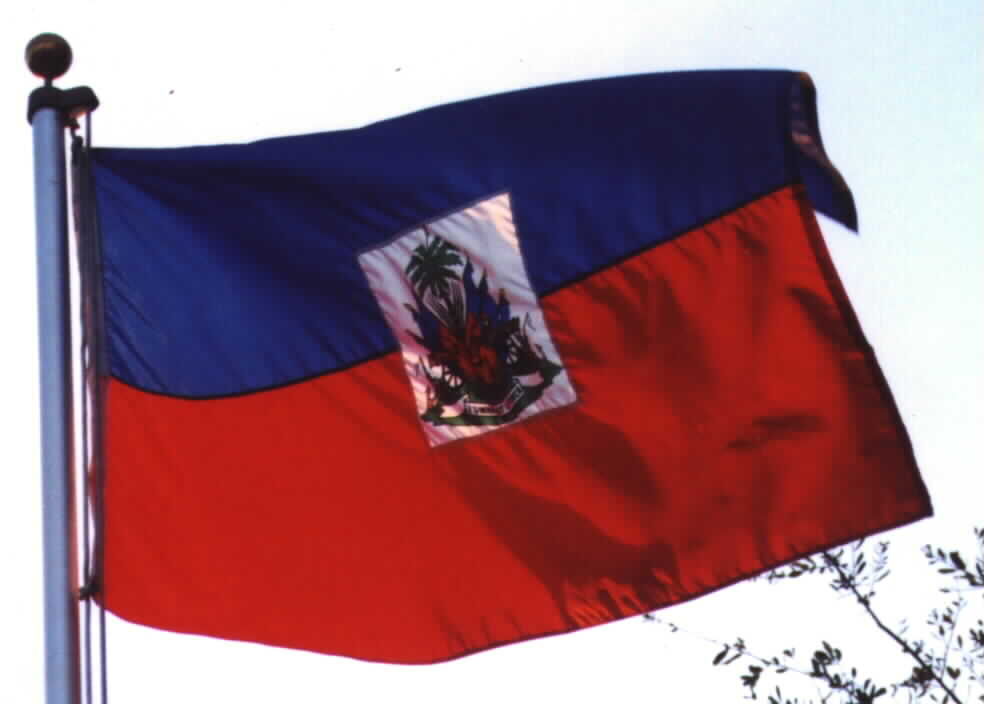
A LOOK AT HAITIAN HISTORY FROM A HAITIAN PERSPECTIVE
By Noe Dorestant, E.E.
Haiti (Ayiti), a Tainos word meaning, "Land of mountains", was first given its name by its first inhabitants the Arrawaks and the Caraibe Haitian Indians, who were a peaceful and happy people. In those days, before 1492 (before the so called discovery of Haiti) there were five well organized Indian kingdoms in Haiti: the Magua, the Marien, the Xaragua, the Maguana, and the Higuey. Haiti was self sufficient at the time and its early inhabitants lived in perfect harmony with the land that they use to cultivate a great deal of the foods that Haitians still eat today. They also practice hunting to get meat. They worshiped nature and had traditional rituals performed at the rhythm of the drumbeat.
Then came Christopher Columbus and the life on this paradise peaceful island would never be the same. Colonial powers have since 1492 claimed and occupied Haitians land.
Starting with the Spanish exploration/occupation (1492-1697), under the Ryswick treaty of 1697 the Spanish gave up control of 1/3 of the western side of the island of Haiti to France.
The French colonization (1625-December 4th, 1803).
The Imperial Spanish (partial recolonization of 1792-1794) with the complicity of Lieutenant General Toussaint Louverture and rival Biassou of the folowing French Saint-Domingue colonial cities: Valiere, Le Trou, Fort Dauphin, Grande Riviere, Ouanaminthe, Limbe', Le Borgne, Ennery, Plaisance Gonaive.
The British (partial occupation with French plantation owners complicity from 1793 to May 31st 1798 of the following Saint Domingue French colonial cities: Mole Saint-Nicolas, Saint Marc, Arcahaie, Port-au-Prince, Jeremie. The British who wanted to occupy Saint Domingue by all means, insulted General Laveaux of Port-de-Paix and General Rigaud when they offered large sum of money, so they could buy out the right to occupy Port-de-Paix and part of the South.
Later on the first North American/USA occupation(July 28th, 1915-August 21st, 1934).
Most recently the second US led occupation/intervention (September 19th, 1994 thru March 1995). Transfer of occupation control from the US troops to United Nations troops was agreed by the US Congress in March of 1995. United Nations occupation (March 1995-November 30th, 1999). In 1999, Permanent Security Council member-state China threatened to veto any further extension to mandate UN occupation of Haiti.
From 1995 to 1999, an unprecedented four extensions were voted at the UN to give mandate to the United Nations to continue the occupation of Haiti (Haiti is one of the original founding member of the United Nations, the father of the Panamericanism, the second independent Republic of a diversity of people indian/black/white/mulato since 1804) against the will of the Haitian people and in violation of the Haitian national Constitution.
Haiti's people like most of its neighbors of the Caribbean were forced to work for the benefit of others as slaves. The original Indians who were estimated to be 1 million when Christopher Columbus arrived, died by the thousands when they were forced to work against their will. (Some of the native indigenous Indians also died from comunicable diseases brought by the European settlers they had befriended, as well as diseases brought in by some exotic European animals such as: dogs, horses, rats etc...)
Africans were also imported to do slave labor works (although they are myths suggesting that Africans, who were also great navigators and great warriors may have visited and inhabited the island long before Christopher Columbus).
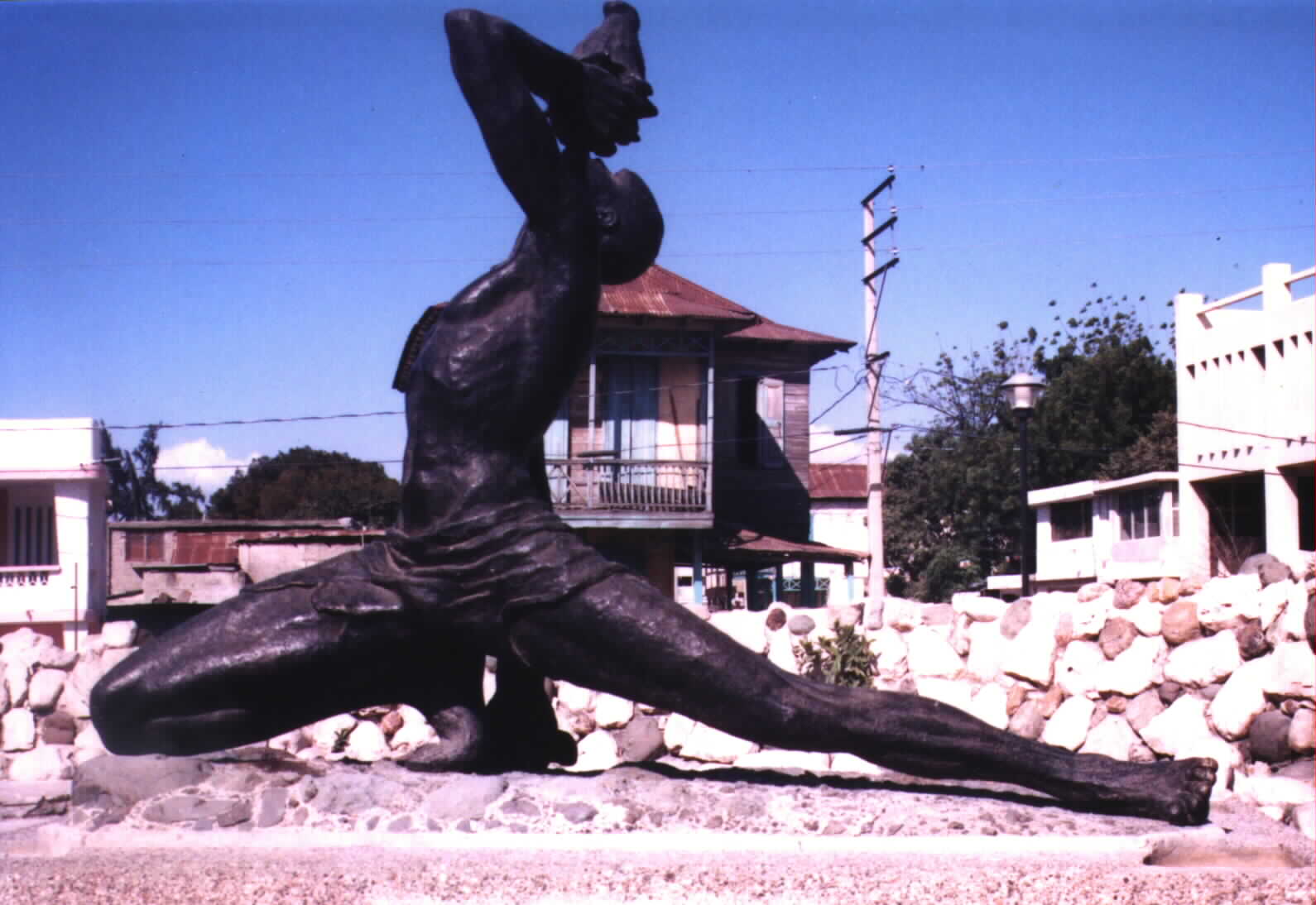
Statue honoring Haitian unknown freedom fighther (Negre Marron), using the conch shell "lambi/conque" to make the rallying call for freedom.
There were also slaves from Europe, known as thirty six months slave, who in exchange for the right of passage that they could not afford, voluntarily accept to work as slave for thirty six months, so they could later on earn the right to be on the island with the other Europeans.
From around 1774, in the British thirteen colonies of the America, the subjects were fighting against unfair taxation and out of that battle was born on the 4th of July 1776 a new nation, the United States of America, for which Haitian volunteers such as: Henri Christophe, Rigaud, Beauvais among the most famous fought for the cause of American freedom in Savannah, Georgia. French Admiral, Comte D'Estaing brought some of the Haitians to help in the US war of independence after the George Washington's liberation army was almost defeated by the British colonial army. Some of the Haitians fought under the command of famous French General Lafayette. Haitian volunteers also fought under the command of French General Comte De Grace in the famous sea battle of Yorktown, Virginia, one of the most decisive battle in the American war for Independence.
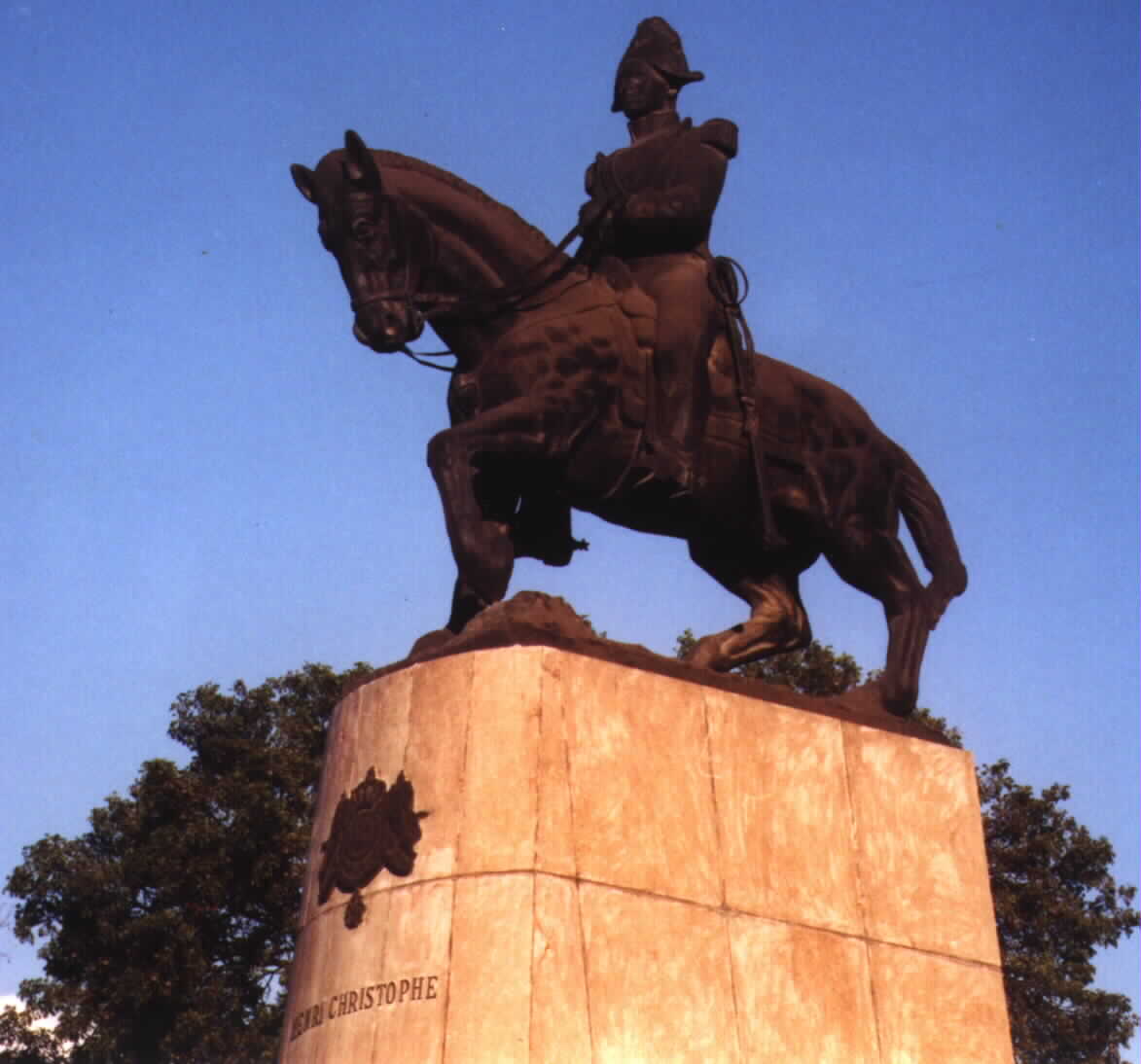
Statue honoring Haitian General/President/King Henri Christohphe, one of the Haitian volunteer who fought under the French to help US gain its independence in 1776. Following the order of Jean Jacques Dessalines, he had built the Fort Citadelle Laferiere (considered today as one of the eight wonder of the world/Patrimoine de l'humanite').
Meanwhile the Colonial powers of the era: France, England and Spain fought amongst themselves for the supremacy of the sea and land elsewhere. At home, the French had their French revolution, took over La Bastille (prison and symbol of absolutism) on July 14th 1789, captured and forced Louis XVI and Marie Antoinette to accede in June 1791, then the Republicans executed the king by guillotine on January 21st, 1793, declare their country a republic to do away with monarchy and special privilege forever by moving forward with the enforcement of the Declaration of Human Rights laid out in writting much earlier on August 18th, 1789 wich proposed that all men are born equal an remain equal in the eye of the Law "Equality between men" "L' egalite entre les hommes". It is also worth noting that the Black Code of 1685 (Le code noir of 1685)had already foreseen in writting the same civil and political right for the black and free mulatoes of Saint Domingue, at the same level that it was guaranteed for the white French settlers. On April 4th, 1792, the French legislative body in France made public a decree, under which men of colors (mulatto) and free blacks were entitled to vote and occupy political position. Sonthonax a young lawyer of Paris was chosen by the French legislature and was sent to enforce this decree in Saint Domingue/Haiti. It is evident, that this decree did not favor the French colonists, who had kept the mulattos(descendents of white French settlers and black Africans) as their prisoners in the southern part of Haiti. It is also obvious that Sonthonax was philosophically up to the task, since he had written himself a year earlier that: "Les terres de Saint Domingue doivent appartenir au noirs. Ils les ont acquises a la sueur de leur front.(The lands of Saint Domingue/Haiti must belong to the blacks. They have earned them with the sweat of their labors.)" On august 29th, 1793 Sonthonax abolished slavery in the entire Northern section of the colony of Saint Domingue. In 1796 the third Civil Comission brought from France 30,000 riffles. While Sonthonax distributed the riffles to the indigenous people of Saint-Domingue, he told them: "Voici votre liberte'! Celui qui vous enlevera ce fusil voudra vous rendre esclaves." "Here is your freedom! The one who would take away this riffle would wish to make you slaves."
By 1797 Haiti had made great progress toward equality between men that the French had proclaimed to the world and its people not excluding the colonies. Although slavery was not totally abolished, it had an army, which consisted of 51,000 men of which 48,000 were blacks or mulattos and 3,000 were whites or Europeans. It was this army, which under the command of black Haitian Brigadier General Toussaint L'Ouverture (Toussaint also known as Pierre Dominique and also nick named Fatras Baton, was born a house slave in 1743 on the Breda habitation, where he had the primary responsibility of taking care of horses, while performing this task he became a self taught vetenarian, a great horse rider and also an endurance swimer. His godfather, Pierre Baptiste showed him how to read and write, he used his reading skill to self-teach himself many other skills. He was considered a slave beyond the age of 40, until he bought his freedom with his own money, which he had earned as a coachman and manager of the Breda plantation. (Toussaint Louverture as a free man and a military leader in the French colonial army of Saint Domingue later made his own fortune from the exploitation of five of his own coffee plantations in the vicinity of Ennery and Saint Michel de L'Atalaye and farms in the Artibonite region.) He was of African ancestry, descendent of the Gaou-Guinou military family from the Aradas kingdom in the west African country of Dahomey, a former French colony until 1960, known today as Benin.) that the French were victorious in defeating the British, who were trying to take over Haiti with the complicity of the French settlers/colonists, who did not agree with the French legislature decree for equality to vote, just granted to the mulattos and the free blacks. They would rather commit the sacrilege of favoring British conquest of the part of Saint Domingue where they had control, rather than submit to the rule of the French law of France (although at this time England was still one of France fiercest competitor at sea and wherever rich lands could fall prey/victim to the greed of armed settlers/colonists of Europe). Before leaving the island, the English, under Major Maitland entered in a dialogue with the Haitian General Toussaint Louverture, so he could secure some commercial interest for England. The British with full military honor received General Toussaint Louverture and was returned the control of Port-au-Prince, St Marc and Arcahaie in April, 1798 and Mole St Nicholas on August 31, 1798, before they left the island.
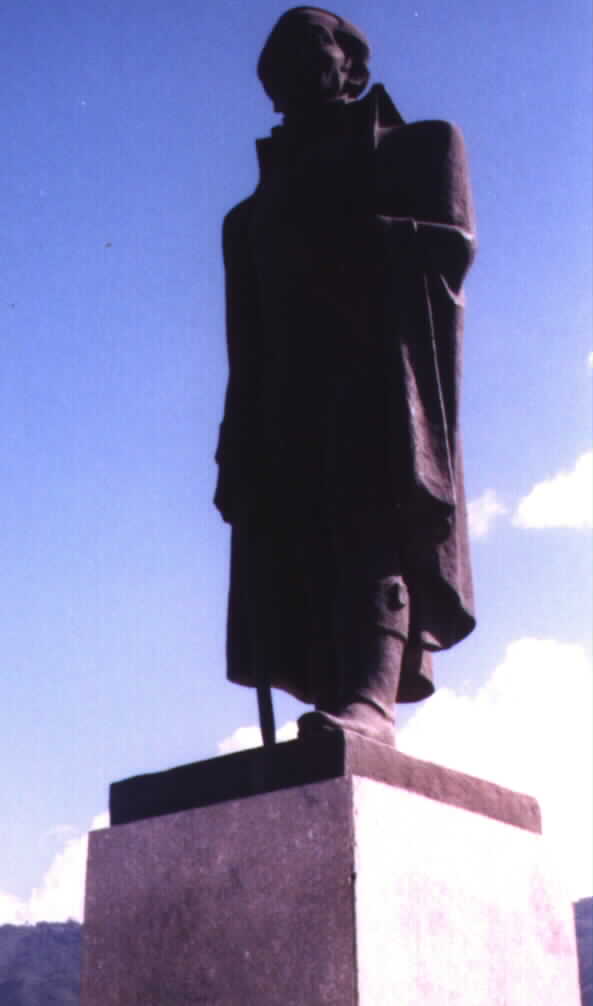
Statue of Haitian hero "Le premier des Noirs", Brigadier General Toussaint Louverture." En me renversant, on n'a abattu a Saint-Domingue que le tronc de l'abre de la Liberte' des noirs, il repoussera par les racines parce qu'elles sont profondes et nombreuses." "By overthrowing me, they have only brought down in Saint-Domingue the trunk of the tree of freedom of the blacks, it will grow again by its roots because they are deep and numerous."
Toussaint later on, to the displeasure of the French decided of its own power to forgive all the whites who had fought with the British against the French.
During the first week of January 1801, General Toussaint Louverture left Mirebalais and led his army of 25,000 men to a campaign of reunification of the island, he took over Azua on January 14th and his war companion General Moyse entered Santiago on January 15th. On January 28th 1801, General Toussaint and his army entered triumphantly in Santo Domingo, where he was received by the Spanish Governor, Don Garcia, who then gave him the key of the city during a welcoming ceremony, where had gathered: the local Spanish authorities, the army and the civilian local population. One of Toussaint greatest human deed during the reunification was the proclamation and the abolition of slavery in the eastern side of the island Saint Domingue/Hispaniola/Espanola.
By the end of 1801, France self proclaimed First Consul, Napoleon Bonaparte decided to challenge the authority of General Toussaint Louverture with the ultimate goal of reestablishing slavery (partly to please: his wife Josephine Bonaparte a Creole born of affluent French parents who owned slaves on another island of the Caribbean, which is still today a French colony/territoire d'outre mer and also to please the Colonists/French settlers of Saint Domingue who were opposed to Sonthonax policy of political equality. Furthermore history reports that Sonthonax himself practiced equality and made it a reality for his own life by spousing a black colored woman of Saint Domingue, he fell in love and live with on the island, until he was selected by Toussaint Louverture on September 14th, 1794 to be one of the thirteen deputy, who would represent the colony in France) in the autonomous colony of Saint Domingue. Napoleon sent a huge army of about 22,000 men and a flotilla of eightysix warships toward Saint Domingue.(Ironically two members of that French military expedition were the two sons of Toussaint Louverture, Isaac and PLacide, who had been sent years earlier to be raised in France at the expense of the French republic, while Toussaint had been promoted to the rank of General of Division for his service in the French colonial army.)
At his arrival in Haiti, French General, Leclerc, brother in law of Napoleon ordered Toussaint to surrender, but the latter refused. Toussaint in reverse swore to burn up the place rather than surrender, and ordered his indigenous generals such as: General Christope to burn Cap Haiti, General Maurepas to burn Port-de-Paix, General Dessalines to burn St Marc, General Vernet to burn Gonaives etc... This may have been the beginning of the rebellion, which would lead into the war for independence by the elite of the Haitian generals, who were until then one of the best trained and equipped army in the colonies devoted and loyal to France. On February 1st, 1802 Leclerc ordered Christophe to surrender Cap Haitien, the latter following the order of Toussaint declared, that he will not surrender until it is reduced to ashes and that even on these ashes, he will continue to fight him. In Santo-Domigo, Paul Louverture surrendered to the French, Laplume did likewise in Cayes a southern province of Sain-Domigue. There were fierce battles in Port-de-Paix between indigenous General Maurepas and French Generals Humbert and Debelle. The resitance and courage of the indigenous liberating army would take place on the hill top of the old Fort named "La Crete A Pierrot", built by the English during their temporary occupation of Petite-Riviere in the department of Artibonite. On Mars 4th, 1802, the indigeneous soldiers resisted the French assault led by Debelle, 300 of his 2000 soldiers lost their lives in the battle and Debelle was forced to withdraw. On Mars 11th, Dessalines realized that the entire army of Boudet was at the foot of the hill ready to attack. It was then that he uttered these words that would symbolize the will of the indigenous soldiers to fight for their freedom at any cost "Je ne veux garder avec moi que des braves. Que ceux qui veulent redevenir esclave des Francais sortent du fort. Que ceux au contraire, qui veulent mourir en hommes libres se rangent autour de moi" "I only want the braves to stay with me. Those who wish to become once again French slaves can make their way out of this fort. Those on the contrary who wish to die as free men may take their place around me". By unanimous voice, they all responded: "Nous mourrons tous pour la Liberte'!" "We will all die for freedom!" During the French assault of La Crete-a-Pierot General Leclerc was wounded, General Boudet lost seven hundred soldiers. The fort was already surrounded by French troops, when Rochambeau came along with his troops, which will also suffered heavy lost during their assault of the fort. Under the corver of darkness, Dessalines found a way to leave the fort so he could seek reinforcement. It was during Dessalines outing that the indigenous army, wich was running out of foods and amunitions, under the command of Magny and Lamatiniere managed to break the French line to escape to safety by the act of one the most brilliant military maneuver act of courage during the struggle for freedom and independence of the indigeneous people of the island of Saint-Domimgue. After many battles French General Leclerc signed a truce with Toussaint Louverture, which was considered defeated, yet waiting for the appropriate time to resume battle. Using deception Leclerc invited Toussaint to a meeting under the disguise that he was seeking his trusted advise. Toussaint succombed to the trap and was arrested by surprise on the George habitation near Gonaives, and was later deported to France, where he later died in a cold prison at Fort-de-Joux on April 7th, 1803. It was during his deportation to France that Toussaint Louverture made his prediction for Saint Domingue with these words: " En me renversant, on n'a abattu a Saint-Domingue que le tronc de l'abre de la Liberte' des noirs, il repoussera par les racines parce qu'elles sont profondes et nombreuses." "By overthrowing me, they have only brought down in Saint-Domingue the trunk of the tree of freedom of the blacks, it will grow again by its roots because they are deep and numerous."
Meanwhile the English who had not forgiven the French for taking over some of the lands they thought they had conquered and jealous of French military sucess, decided one day without provocation and no war declaration to capture 1200 French and Dutch boats and later sent a flotilla to blockade the ports of Saint-Domingue. It was during this British blockade that the fortune of Toussaint Louverture estimated to 80 million francs disappeared. A great economic blow to the new nation which was about to be born.
The events were moving now in favor of the indigeneous revolution. The South of Saint-Domingue, which had remained loyal to France under Laplume is now in full rebellion under Nicolas Geffrard, as the troop of French General Rochambeau began to suffer some defeats. The leaders of the indigenous army, namely black General Jean Jacques Desaalines and mulatto General Alexandre Petion, who had now gained confidence in their ability to lead their troops in mountainous battlefield they were familiar with and win the war for freedom against the French army, met in Arcahaie on May 18th, 1803 for the creation of a symbolic flag of their unity of their common cause for freedom from the French empire. Dessalines by a symbolic act removed the white from the French flag, then unite the blue to the remaining red to represent the union of the blacks and the mulatoes against the white French opressors of the time.
After ten years of struggles and uprisings, on November 18th, 1803, Haitian soldiers led by Brigadier General Capois La Mort won the last decisive battle against the French army of Napoleon led by Rochambeau in the "Combat de Vertieres" in the North of Saint-Domingue. With this epic and courageous victory of Capois Lamort followed by the final take over of Charrier by Garrier which gave the indigeneous army the necessary strategic advantage to take out and silenced the canons of Rochambeau in Vertieres. With their canons out of action, the French armey under Rochambeau was forced to abandon Vertieres. Later on the defeated French army surrender Cap Haitien on November 28th, 1803 and Mole Saint-Nicolas on December 4th, 1803. Haiti's independence was symbolically won on the battlefield and was declared independent on January 1st, 1804. Boisrond Tonerre drafted the Haitian act of Independence, which was red in a ceremony led by General Jean Jacques Dessalines and signed by a select group of Generals from the Haitian elite army for Independence, on the ground named "Place des Armes" in Gonaives.
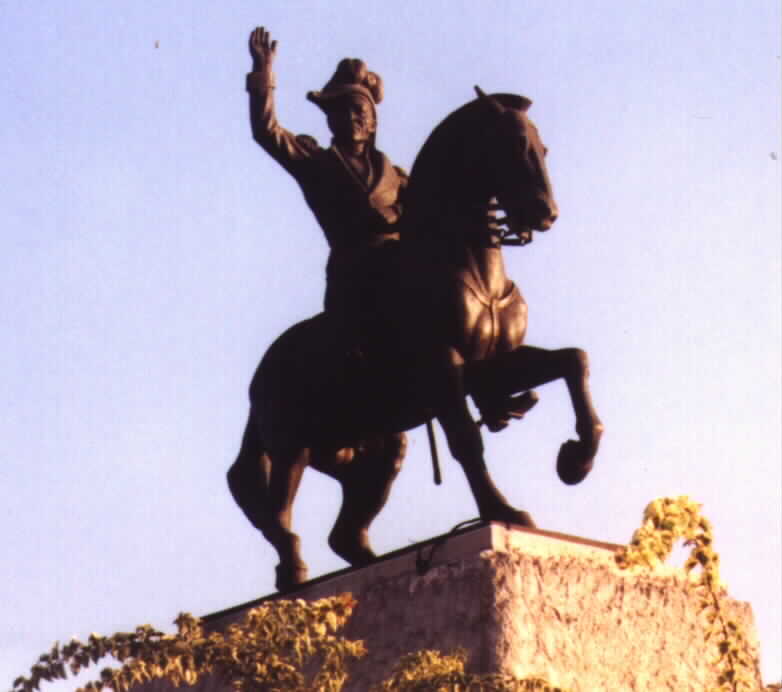
General/Governor General for life Jean Jacques Dessalines, Father of Haitian Independence, January 1st,1804. On Sebtember 22nd, 1804 he was proclaimed by his honor guard and his loyal half-brigade as Emperor like Napoleon and was crowned on October 8th, 1804 as Jacques the First. An imperial constitution was created for Haiti in 1805 with provision for sharing of power with the Emperor, the position for a Minister of Haiti internal Affair, a Minister of Finance, a Minister of War and a Secretary of State." Vivre libre ou mourir! Live free or die!"
After the fall of Napoleon in France around 1814, the eastern side of the island, Santo Domingo returned to the control of Spain as a colony again. However the population was divided as to wether they should stay under Spain control, aspire to the status of independent nation, have an alliance with Colombia, or reunite with Haiti in the west, as an undivided independent island nation. In 1822, President Boyer (former Commander in Chief of President Petion presidential guard of Haiti) would make the latest view a reality. Using an army of 20,000 soldiers, he made his way to reconquer and reunite the island as Toussaint did before, but this time, he entered via Ouanaminthe and Lascahobas. The northern army column was spearheaded by General Bonnet and the western Haitian army colum was spearheaded by President Boyer. On February 9th 1822, Boyer and its army entered triumphantly in Santo-Domingo. The reunification lasted for 21 years.
Meanwhile, France under Louis XVIII tried in vain from 1814 to 1823 thru diplomacy to regain Haiti for the planters colonists. Boyer often reasserted his position: "Let us swear to posterity, to the whole world, to throw off not only the domination of France, but that of any power that would seek to subjugate us, and to die rather than to cease to be free and independent." However Boyer would agree to pay later an indemnity of 60 millions francs (generated mostly by income from the hard work of Haitian peasants farmers, who planted and sold the exclusive high quality Haitian mountain coffee for years to pay the debt) to compensate the lost of the colonists, to get the recognition of Haiti's independence and put a stop to all French government claim on behalf of the colonists on Haitian independent and sovereign territory.
Less than a decade after its independence, Haiti, the second republic in the Americas and the first black independent nation in the world, began to help its neighbors in South America to gain liberty as well. During Alexandre Petion presidency, Simon Bolivar "the Liberator" came to Haiti to seek help for his struggle to liberate his country Venezuela from Spain. Petion gave Bolivar: money, weapons, ammunitions and even Haitian volunteer soldiers to help him fight for freedom. The only thing Petion asked in return was abolition of slavery in all the territories that he may later help liberate. Simon Bolivar with the help of Haiti proclaimed Venezuala independence in 1812 and truly liberated: Colombia in 1819, Venezuela in 1821, Ecuador in 1822, Bolivia and Peru. It is even said that Bolivar had promised to Petion that as a gesture of gratitude that he will include part of the red and blue of the Haitian flag in the flag of the countries that he will gain independence for with Haitian help. Thus the reason for the red and blue in the flags of: Venezuela, Columbia and Ecuador. History even reports that both the Venezuelan and the Colombian flags were made in the port of Jacmel, Haiti. However, Haiti the father of the Pan-American movement was later bad mouthed by his jealous neighbors, who spread the words that: Haitian leaders had vision and ambition to create a black empire in South America, hence Haiti became a de facto outcast, and its people would experience a great deal of injustice and set back as a bitter reward for its good deed for freedom and liberty.
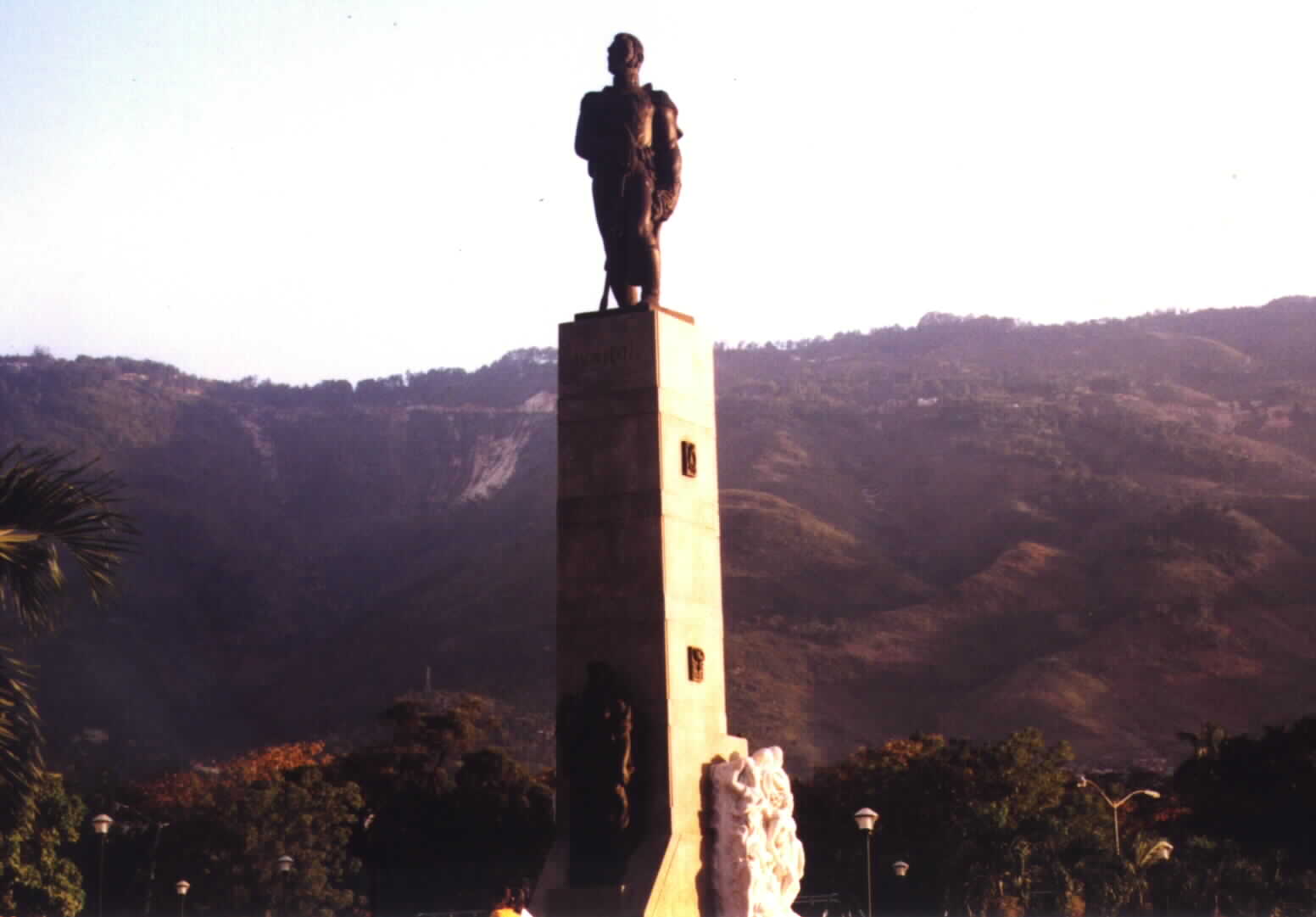
Statue of Haitian President/General Alexandre Petion, immortalized on the Champ de Mars of Port-au-Prince, Haiti, where he is revered as the father of the Panamerican movement, who helped Simon Bolivar to liberate South American countries such as: Venezuela and Colombia.
After the assasination in a coward ambush of Emperor Jean Jacques Dessalines on October 17th, 1806. Haiti was declared a republic on December 27th, 1806 by the Haitian Assembly Constituante, which voted for the first constitution for the republic of Haiti. On December 28th, 1806, Henri Christophe became the first elected President of Haiti, for a period of four years. However when President Henri Christophe was declared outlaw by the senate, and new election was called to order. General Alexandre Petion was elected as the second President of Haiti on March 9th, 1807. By 1810 Andre Rigaud was President of the South of Haiti with Jerome Maximilien Borgella as president of the Assembly departmental of the South. Alexandre Petion was elected for a second term as President of a divided Haiti in 1811, but could only govern the West of Haiti due to the ongoing Haitian civil war. Outlawed President Henri Christophe had himself self crowned King of the Northern and Artibonite sections of Haiti. Citizen Alexandre Petion was last reelected for a third term as President of Haiti in 1815, by a minority of the Haitian senate.
Upon taking consideration of Haiti's political and economical stability, France of Charles X recognized Haiti's independence on April 17th, 1825, almost 25 years before she abolished slavery in all her colonies. However there was a condition, Haiti were to pay to France an economically destructive indemnity of 60 millions French francs on behalf of the French colonists, who had lost their plantations, when Haiti gained its freedom on the battlefield. The British also upon evaluation of Haiti's stability recognized her independence in 1833, shortly after the British Emancipation act of 1833.
On February 28th, 1844 during the Haitian government of Riviere Herard, the eastern side of the island proclaimed itself independent as revolutionaries and peasants took over the streets of Santo Domingo. President Riviere Herard attempted to regain control in the East. However due to internal political strife and insurrectrion in the West by the Piquets and other political rivals, he was forced to abandon his mission and left into self imposed exile in the neighboring island of Jamaica, a neighboring island which was still at the time a colony of the British empire.
In March 1849, Haitian President Faustin Soulouque in his quest to reunite the Eastern side of the island, crossed the Ocoa river with 15,000 soldiers while overcoming fierced Dominican fighting resistance. To the surprise of his victorious troop, President Soulouque gave the order to withdraw from his headquarter at Azua, shortly after he was misinformed of an unprising in Port-au-Prince, where he did not have full support of neither the people nor the respect of the senate (Since he was elected by the senate almost as a joke, after several tie votes in the election process of the two leading candidates: Army General Paul and General Souffrant. Senator Baubrun Ardouin proposed that the candidate with the least amount of vote is elected, and that is how he became President with only one vote.) During his army hasty and disorganized withdrawal, many Haitian soldiers lost their life at the hands of the Dominicans they had just attacked and defeated.
In 1855 Faustin Soulouque as self crown Emperor Faustin the First attempted another expedition to the East, but this time he met unsurmountable resistance from famous Dominican General Santana and was forced to turn back with his poorly equiped and financially corrupt army, which suffered heavy casualties again during the pull back.
On March 28th, 1860 two delegates sent by President Geffrard signed a treaty with the vatican, it was later approved by the Haitian Senate on August 1st, clearing the way for normal relation and the recognition of the Catholic church as the official church of Haiti (Voodoo religion practices with mainly African ancestral roots mixed with Caribbean Indian religion ingredients and some Midle Eastern and European Judeo Christian influences remain the unofficial meltingpot folk religion of most Haitians). In that same year, General Santana, President of the Dominican Republic returned control of his country back to Spain. However President Geffrard saw in this action a threat to Haiti's sovereignty as a nation. He felt that it would be a disaster to share power on the island with a former slave master/slave holder nation and still colonial power Spain. He decided to actively support the independence movement of the Dominican Revolutinaries within the Dominican Republic. The Spanish government would pressure him and force him to pay and indemnity for his effort on behalf of the independence movement in the Dominican Republic. After complying to the Spanish government demand for reparation money, President Geffrard was harshly criticized by the Haitian people in the West, for his lack of courage in backing down. For in the mind of the people: an Independent Dominican Republic represented a lesser evil than Colonial Spain.
Meanwhile the United States with the growth of cotton Capitalism and continuing slavery practice, would not permit the recognition of the free Negro/mulatto sister republic until President Geffrard of Haiti on May 22nd, 1861 made an appeal to the Republican President Abraham Lincoln for the long awaited recognition of Haiti or face the possibility of Spain presence again in the Dominican Republic and the opportunity for Spain to have dominion on the region and threaten the stability of Haiti, with which the US had great commercial exchange so far.
During debate on the US senate floor about recognition of Haiti, Democratic senator, Garret Davis of Kentucky declared that: "Washington society was not ready to receive a black minister". On the same line, Democratic senator, Saulisbury of Delaware objected to the eventual presence of Haitian minister in the Senate gallery reserved for diplomats. It was Charles Summer, a Republican Senator of the state of Massachusetts, who made the case for Haiti, when he pointed out in a speech on April, 23, 1862: "The traditional policy of the United States required recognition of a nation that had been independent in fact for almost sixty years and that had been recognized by other powers. He further stressed the importance of the commerce of the United States with Haiti, standing above that with Prussia, Sweden, Turkey, Japan and Russia, countries with which the United States had ministers."
Charles Summer argument in the US Senate was convincing. On June 5th, 1862, President Lincoln signed the bill for the appointment of commissioners to Haiti and Liberia, his decision was perhaps a side effect of the South's Secession from the Union. Benjamin Whidden of the US state of New Hampshire was appointed weeks later as the first diplomatic representative of the US in Haiti. On April 27th 1863, President Geffrard of Haiti made this only comment at the opening of the Legislature: "The government of the United States has recently recognized the sovereignty of the State of Haiti. This recognition will without doubt, give a new impulse to the commercial transactions between the two countries. The other consequences of this great act belong to the future."
Seven years later, in 1870 President Ulysses S. Grant (Grant was the last US President to own slaves on US soil.) of the USA entered a treaty with President Baez of the Dominican Republic to annex the Dominican Republic. The Haitian President of the time, Nissage Saget saw the treaty as a threat to Haitian sovereignty on the shared island and decided as his predecessor President Geffrard to support the independence movement of the Revolutionaries in the Dominican Republic. The treaty was turned down by the US senate, thanks again to the humanitarian intervention of US Republican Senator of the Northern State of Massachusets, Charles Summers, who years earlier argued successfully for the recognition of the independence of Haiti on the same floor of the US senate.
Both Haitian Presidents: Nicolas Geffrard and Nissage Saget may have been right in their apprehension about US intention, since history will prove them right, in 1915 during the failed Haitian Presidency of Vilbrun Guillaume Sam and the U.S. President Wilson administration. When political in fighting caused by poor financial planning (The Haitian government had just taken a big loan from the French Government, for the ultimate purpose of creating the Haitian National Bank not to mention some ongoing uneasiness over Belgium and other European countries investment in the Haitian cultivation of coffee and coccoa for Europe) managed by weak nationalists and unstable successions of short-lived feudal Haitian governments, gave the US the opportunity and the excuse: not only to occupy Haiti militarily with the naval and land invasion on July 28th, 1915 led by Admiral Capertown aboard the Navy ship, Washington, which was stationed in Cap-Haitien since July 1st, under the pretense of protecting the lives and properties of North Americans and foreigners. It is rather an ironic historic fact that: when the US marines landed on the beach of Bizoton near the Haitian Capital of Port-au-Prince, they were guided by four Haitian marines. Capertown during the invasion had also dispathched from the US base of Guantanamo Cuba, the US destroyer Jason with the 24th company of marines, and also from Philadelphia arrived reinforcement for the invasion of Haiti, the following US battle ships: the Connecticut, the Eagle and the Nashville with five companies of the second regiment of Marines, under the command of US Colonel E. Coles.
This was also a financial occupation as President Wilson would admit later. The Haitian economic system was taken over, beginning with: the custody of the gold reserve, the Haitian customs, the control of Haiti's national Bank etc... From that point almost all fiscal and financial matters had to be approved by the state department of the occupying forces. There was also a quasi take over of all Haitian ministries by US generals originally of the mostly still segregated US deep south. A US general even headed the Haitian ministry of Education. During the occupation, Haiti lost its pride and autodetermination as a sovereign nation, and seems to have lost also the control of its destiny as the sister republic nation, which had as much right to be guided by the aspiration of its own people, as its strong neighbor on the North would want for its own people.
The US agricultural based investment companies and merchants on Wall street stand to benefit the most from the
US occupation. The small Haitians family farm with the blessing and complicity of the Haitian government were sold to large US company such as: HASCO (Haitian American Sugar Company, established in 1915 over 24,000 acres scatered between Leogane and the Plaine du Cul de Sac.)
During the occupation US companies used previous right to operate, acquired during the shameful railroad and Mac Donald financial contract (Le contrat de la Honte), negotiated by the Gorvernment of Antoine Simon (1908-1911) with some American financial institutions and advisers, who took advantage of Antoine Simon's government enlightened desire to modernise Haiti (During the progressive government of Antoine Simon: Port-au-Prince was modernized with the creation of the first electrical power plant, which provided electricity around the clock for the entire metropolitan capital, the vast majority of the streets of Port-au-Prince were paved, the first Ford model cars were introduced in the country and the wharf of Port-au-Prince was built in the bay to allow the docking of modern cargo ships and facilitate the export of Haitian goods and the import of modern foreign goods). In the 1910 Mac Donald/US National rail road contract, the Haitian government of Antoine Simon allowed the US National Railroad Company to use for 50 years free of charge, the right to plant bananas on 20 kilometers on either side of any rail road track built on route proposed to cross the West Department with main train station in Port-au-Prince, to also cover the Artibonite Department with train station in Gonaives, the Northwest deparment with train station in Port-de-Paix and the North department with main train station in Cap Haitien. Small sections of working rail road tracks used by trains/locomotives in Haiti to carry passengers and goods were only built by the "Compagnie Nationale des Chemins de Fer D'Haiti" which had a contract much earlier in 1906 during the Nord Alexis government to: supposedly build rail roads links from Port-au-Prince to Cap Haitien, Gonaives to Hinche and Cap Haitien to Grande Riviere Du Nord. However, only two rail road links were built between Port-au-Prince to Saint Marc and Saint Marc to Verrettes. Very little was done concretely to honor the 1910 "Mac Donald/US National rail road" contract to the satisfaction of the Haitian population, this would cause discontents within the angered Haitian society and will serve as fuel for the second Cacos uprising of February 1911 in the North of Haiti. The often suspect and ill conceived financial contracts with the North Americans (Le contrat de la honte) and lack of executions of proposed plans for development, coupled with inability to repay loans acquired by the Haitian government fron European and American financiers, would ruined the Haitian economy and paved the way for the US occupation forces. The North Americans would then directly take over the Haitian finances, after being misled by promise to help, when the Haitian government were seeking financial security, so it could pay for development and calm down the dischanted soldiers of the Cacos revolutionaries army, which was expanding in numbers as "nouveaux pauvres" peasants continued to join their ranks near Ouanaminthe and other remote locations of the Haitian territory. The Haitian American Development Corporation established in 1926 in the region of Fort Liberte, cultivated exclusively sisal over 14,000 acres of prime agricultutal lands, that the Haitian government supposedly claimed it owned and had rented away to US corporation without compensating the poor peasants who used to live of the agricultural produce of their lands. Some American companies such as the United Fruit and Alantic Fruit Company would have a least harmful impact on the Haitian environment in areas near Port-de-Paix, where they created large plantations of bananas. The Haitian Pine-Aple company had large plantations of pine apples near Cap Haitien. A large section of the Haitian forest throughout the countryside would be lost during clearing for plantation of sisal and rubber trees, thus marking the beginning of Haiti's environmental problem in the arena of visible deforestation of
trees. Part of the peasants population began to suffer from malnutrition "No land, No food".
Most of them no longer had their small farm to cultivate and harvest to feed themselves,
or sell or make exchange to survive, as the founder of the Haitian nation, Dessalines had planned and envisioned
during his short live agrarian reform. In search of a better economic life, poor Haitians
started their mass exodus and began to migrate legally and illegally to other
neighboring islands of the Caribbean, such as Cuba and the Dominican Republic, etc. It is estimated that in the period between 1915-1930 over 400,000 Haitian workers migrated to Cuba, where most worked on sugar plantations financed by US companies, the majority of these Haitian migrant workers ended up disillusioned in the Santiago area of Cuba where they spoke freely on openly Haitian Creole, practiced African base Vodoo rituals like most Cubans and Haitian cultural traditions. According to some historians and social scientist studying the era of the US occupation, the mass exodus of Haitian to neigboring countries such as: Cuba, Dominican Republic and to a lesser degree Honduras, was caused out of despair and the awarenes of the negative changes that the US occupation had brought to the Haitian country side and agricultural environment. The average Haitian could no longer maintain the standard of leaving they had known since 1793, when Sonthonax tried the implementation of France's emancipation law in the colony of saint Domingue, granting the average free Haitian the right to vote as well as the right to buy and own small portion of lands for self sufficient agricultural practice, to assure individual human independence and survival. The destructive phase of the buy out of large portion of Haitian government lands domain by US companies and the monopoly of the cultivation of large sugar cane field solely for the purpose and production of sugar, deprived the small Haitian entrepreneur of his traditional way of competing in the production of sugar cane to be used in the manufacture of a special brand of Haitian alcohol known as tafia, which was squeezed out of the competion when the Haitian government with the complicity of large US company, imposed an unfair tax tariff that made it unprofitable for small Haitian farmers to produce Haitian alcohol and its tafia/medicine/food by-products. Without salary compensation or even employment on the new US plantations to compensate for their lost, most used to be small farmers and has been self sufficient members of the (tradition La Cour) had to look elsewhere for survival. It has been reported that 16,000 hectares were used to cultivate sisal in the north of Haiti (Plaine du Nord and Fort Liberte'), however only 1,000 Haitian workers found job on the once large sisal plantation of the Haitian American Development Corporation, which produced absolutely nothing eatable to feed the local population suddenly out of land to cultivate for its own.
The Haitians people who had enjoyed the freedom to take care of their own country
for over one hundred and ten years, resisted the US occupation and conducted guerilla type warfare
led by Charlemagne Peralt and later Benoit Batraville of the indigenous nationalist revolutionaries of the North called
"Les Cacos", who had a tradition of fighting for social justice (by often taking the law in their own hands) and supporting candidate and government like that of Cincinatus Lecomte, long before the US occupation, were now fighting as liberation army against the unjust Yankee occupation and harmful management of peasants land in the North and Northeast region of Haiti. The Haitian peasants were also unhappy, because of the ill
treatment they received from the US troop, while they worked in a public work
program called "La corvee" reintroduced by the occupying American forces in 1916. The Corvee wasa part of the Haitian rural code of 1854. The discriminatory misused of the this code, which put thousand of Haitians to force labor work during six days of the week, building roads from Saint Marc to Limbe' without a salary and and poor nutrition mixed with harsh treatments by the marines, reminded most of them of the bygone days of slavery before Haiti's
independence, caused discontent and later uprising by the peasants and Cacos revolutionaries. It is estimated between 1919-1920 that at least 4,000 Haitians died in confrontation with US troops (Same period when Charlemagne Peralt was executed/crucified) and that close to five thousand peasants died in the Chabert Camp while under US marines custody. According to some historians the casualities could have been much higher, if one were to recall the Marchaterre incident/drama of December 6th 1929, where unarmed Haitian peasants were machine gunned down by US marines on they way to the southern city of Cayes, after a short arguments with the peasants, the unfriendly US marines opened fire.(The marines assumed these Haitians to be resistance enemy fighters and were eliminated as it was often done during the years of occupation, where the US used their owned proposed convention of 1915, approved by the puppet Haitian Senate on November 12th, 1915 and the US senate on May 3rd, 1916 which gave the US right for a ten years period, to maintain law and take care of Haitian finances.) It was only after diplomatic negotiating effort made by the Haitian President Stenio
Vincent, who came to the US on Mars 22nd, 1934 to continue to negotiate the disoccupation
of Haiti by the US. His visit was followed by a reciprocal trip to Cap-Haitien
on July 5th, 1934 by the US democratic President Franklin Delano Roosevelt. Then came out a
joint press statement to the effect that: the Haitian national guard will be completely
haitianized by August 1st, 1934 and that 15 days later, there shall be no more US marines
on Haitian soil. It was by the way, Franklin Delano Roosevelt, who as sub-Secretary
of the navy under the Wilson administration, had drafted the Constitution that the
US would imposed on Haiti during its 19 years of occupation. Roosevelt was probably
convinced that the continuing occupation would hurt Haiti further, rather than help it,
but the harm was already done. However his change of heart and policy woud clear
the way for Haiti's liberation of direct US occupation with US marines on its soil.
On August 21st, 1934 in a touching ceremony, the Haitian flag flew again
for the first time on Caserne Dessalines (Caserne Dessallines, an impressive modern Haitian army military compound built by nationalist President Cincinatus Lecomte to house elite Haitian soldiers to provide protection for the Haitian national palace. Lecomte was the leader of the Cacos revolutionaries of the North. His proud and progressive government would only last two years 1911-1912. Although he provided some law and order in the sector of public service, his government was black mailed for money by the ever dissatisfied Cacos revolutionary army. The Cacos had helped him overthrown and forced to exile his predecessor, the goverment of Antoine Simon on August 2nd of 1911. His presidency and his life would come to a sudden end when the Haitian National Palace (an unsecure structure made of wood and tin roof) exploded with him and his entourage on August 8th 1912 at 3 AM in the early morning hours, when mostly everyone were asleep in Port-au-Prince besides the guards on duty.)since the US led invasion of 1915. President Stenio Vincent made this circumstantial remark about the Haitian flag:
"Que dersormais, il soit l'embleme d'une petite Nation ayant la volonte' de vivre
dans la Liberte' par l'Ordre et dans le Travail sous l'egide salutaire de la paix
publique."/" Let it be known from now on, that this represents the symbol of a small
nation with the willingness to live in liberty, with order and work under the aegis
salutary of public peace." Haitian President Stenio Vincent would be in Haiti the architect of
Haiti's new own constitution of 1935, created to replace the US constitution of Occupation. Haiti's national palace flying the Haitian national flag, "symbol of a small nation
with the willingness to live in liberty, with order and work under the aegis salutary
of public peace." It was in October 1937, during the second term of Stenio Vincent as
President of Haiti that the Dajabon affair and massacre of Haitian residents
by Dominican guards took place in the Dominican Republic under the Presidency
of Dictator Rafael Leonidas Trujillo. History has reported
that from October 2nd to the 4th of the year 1937, close to 25,000 Haitian
citizens were massacred on the Haitian-Dominican border: on Domician soil
in the city of Dajabon, a neighboring Haitian Northeastern town of Ouanaminthe (ironically they
are geocraphically located on opposite side of River Massacre), some of the Haitians were slaughtered with knives and bayonets near the region
of La Miel, in the interior town of Mola within the Cibao. Massacre also occured close to the border region of a Haitian Savanette, that was ironically just incorporated as part of the Dominican
Republic during borders treaty in 1935, in a region where generations of Haitian residents had children, properties and farms with cows, donkeys, chickens, etc... The order to massacre the
Haitians by Dominicans guards was given after Dominican citizens
complained to President Trujillo about the Haitian residents, while he
attended a dance party in Dajabon. History ironically also reported that
President Rafael Leonidas Trujillo (Dominican President Dictator 1930-1961),
was himself of Haitian descent. His family tree proved that he was the son
of Julia Molina Chevalier, whose family origin is linked back to: Alexis
Carrie' (Haitian Governor of Santo Domingo during Haitian reunification of
the Eastern side of the Island of Hispaniola to the Western side of Haiti),
Jean Marie Saladin (Colonel of the Haitian Army 32nd regiment and Commandant
of the Square and the Commune of Santo Domingo), Bernard Chevalier and Louise
Moreau. All the relatives mentionned in his family tree are of Haitian origins
and mostly part of the affluent Haitian families of Port-au-Prince and its
vincinity, who had a strong tradition of public service in the Haitian
government and the Haitian military. The Haitian Government of Stenio Vincent
and most of his ministers felt that they were duped by the leaders of the neighboring
Dominican Republic, with whom they had invested so much time and efforts
to create normal and friendly relation for their two peoples, which after all
had so much in common, besides blood, a common island and a shared history of
struggle for independence.
Haiti and Haitians have had to strive and struggle against all
attempts and conspiracy to punish and suffocate this young nation, who in
the face of all odds dared to be the first black independent nation in the
world and the second republic in all of America. At a time when all the states
around it still had slaves including: the Americans, French, English, Dutch and
Spanish, who saw in Haiti successful revolution, a threat to their self interest and their
status quo as slave owners. So all was done to boycott, manipulate, isolate and
not recognize Haiti's independence until it was deemed that Haiti was impoverished,
and made weak enough militarily, so that it could not pose a threat to the
status quo, in particular the status quo of slave owners nations. Haiti, since
its independence has suffered from naval blockade, indemnity, ultimatum, embargo and
even occupations, by those of its friends, who thought: they knew what was best for Haiti or
better yet, as history will prove, what was best for their self economic interest.
Haiti's countryside still has reminiscence of its war of bravery for independence.
The ruins of its forts and the life style of its impoverished people remind
us that it has paid dearly to maintain its status of independent nation from
1804 to this day. As Dessalines would have said if he were alive today:
"Vivre libre ou mourir!" "Live free or die!".
Meanwhile his legacy survives.
Haiti that was once surnamed the pearl of the Antilles because of its wealth
in gold and other precious metals and stones, and its natural beauty, has lived
to see its resources and its heritage exploited and mismanaged by its sons,
daughters and foes alike.
Would Haiti rise up from his ashes? That is the question that we keep on asking
as we approach the year 2004 (Haiti's bicentennial, 200 years of independence). The spirit of Toussaint Louverture (Le Centaure de la savane) and his deeply rooted
ideals for his people's freedom and human liberty lives on, as Haiti prepare to
celebrate with the rest of the free world, its bicentenial on January 1st, 2004.
Would Haiti one day rise up from its misery that was either self-imposed or
imposed upon by others? That is for all of us to answer and do something about
now. Champ de Mars in Port-au-Prince, a living Haitian museum, where the saga of Haitian history continue to unfold.
For those Haitians and friends of Haiti who still care and have deeply
rooted love for Haiti. I wish to share with you some pictures, which are by no
means a true reflection of the state of Haiti today. However for the sake of
History I would like to take you to some parts of Haiti, more particularly to
the town of Port-de-Paix, which is well known and respected for the bravery of
one of its son and hero of Independence, Capois La Mort. Who during the final and
decisive battle for Haiti's independence on November 18th, 1803 (Le combat de Vertieres/
The battle of Vertieres) received the applauds of the French soldiers he was
fighting against. French general, Rochambeau even ordered a cease fire so he
could present his homage to this black officer, who had just shown such bravery,
when Capois La Mort got up with his sword in his hand, ordering his troop to
advance after a cannon ball had removed his hat and another one took down his
horse.
Haiti would rise from its ashes and its misery, despite all odds.
Long live Haiti and its people!
Written by: Noe Dorestant,
July 26, 1998.
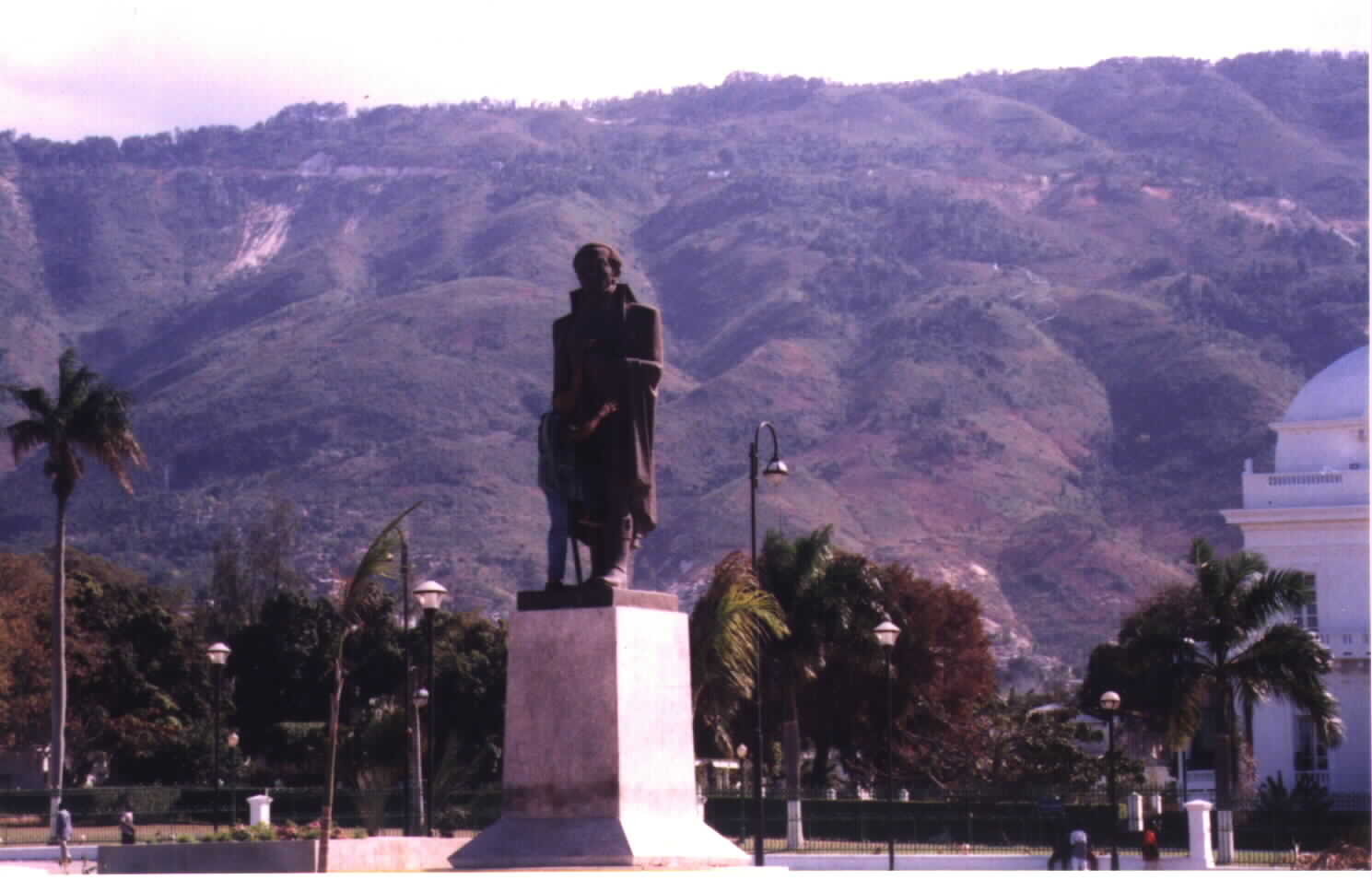
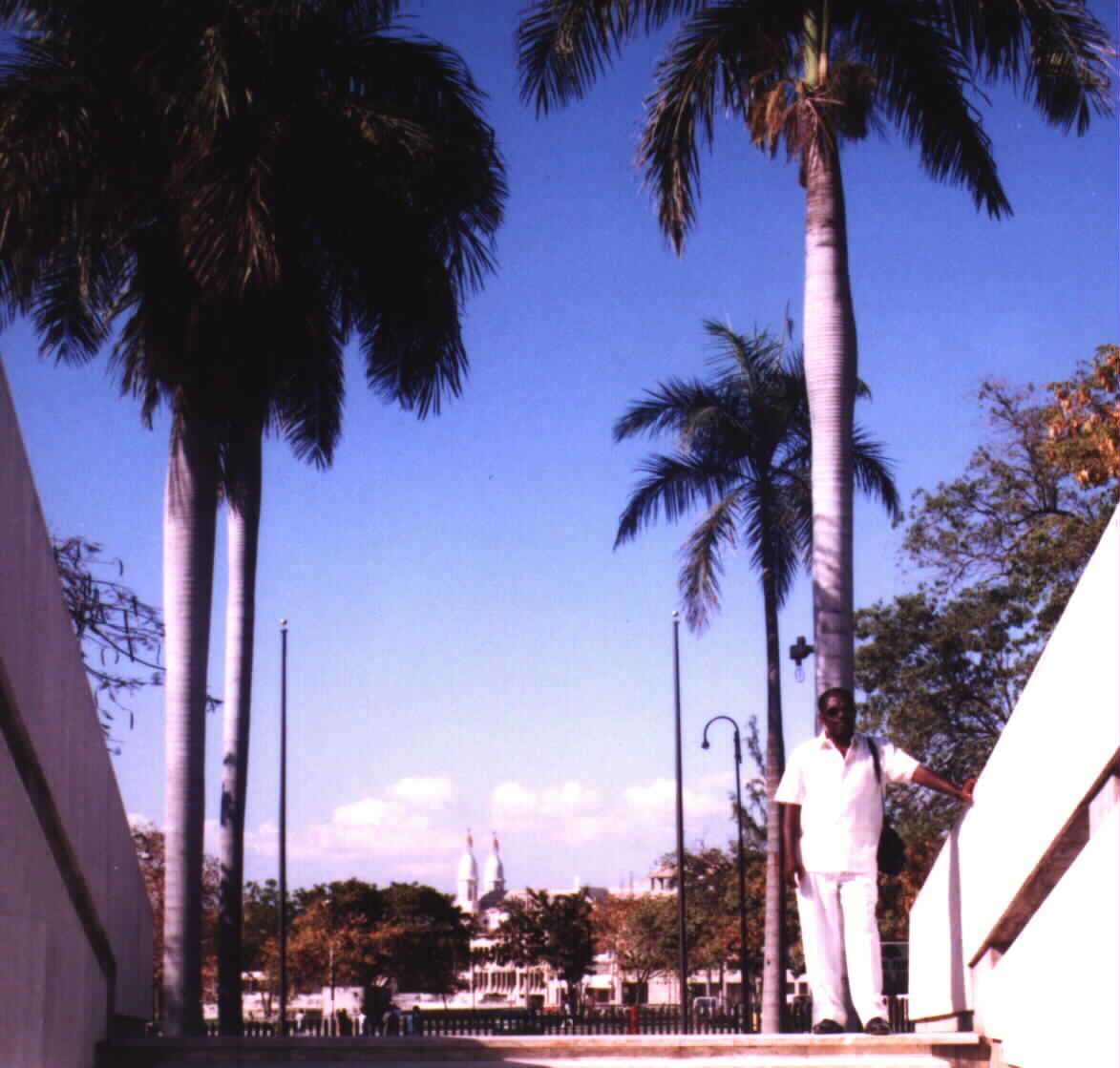


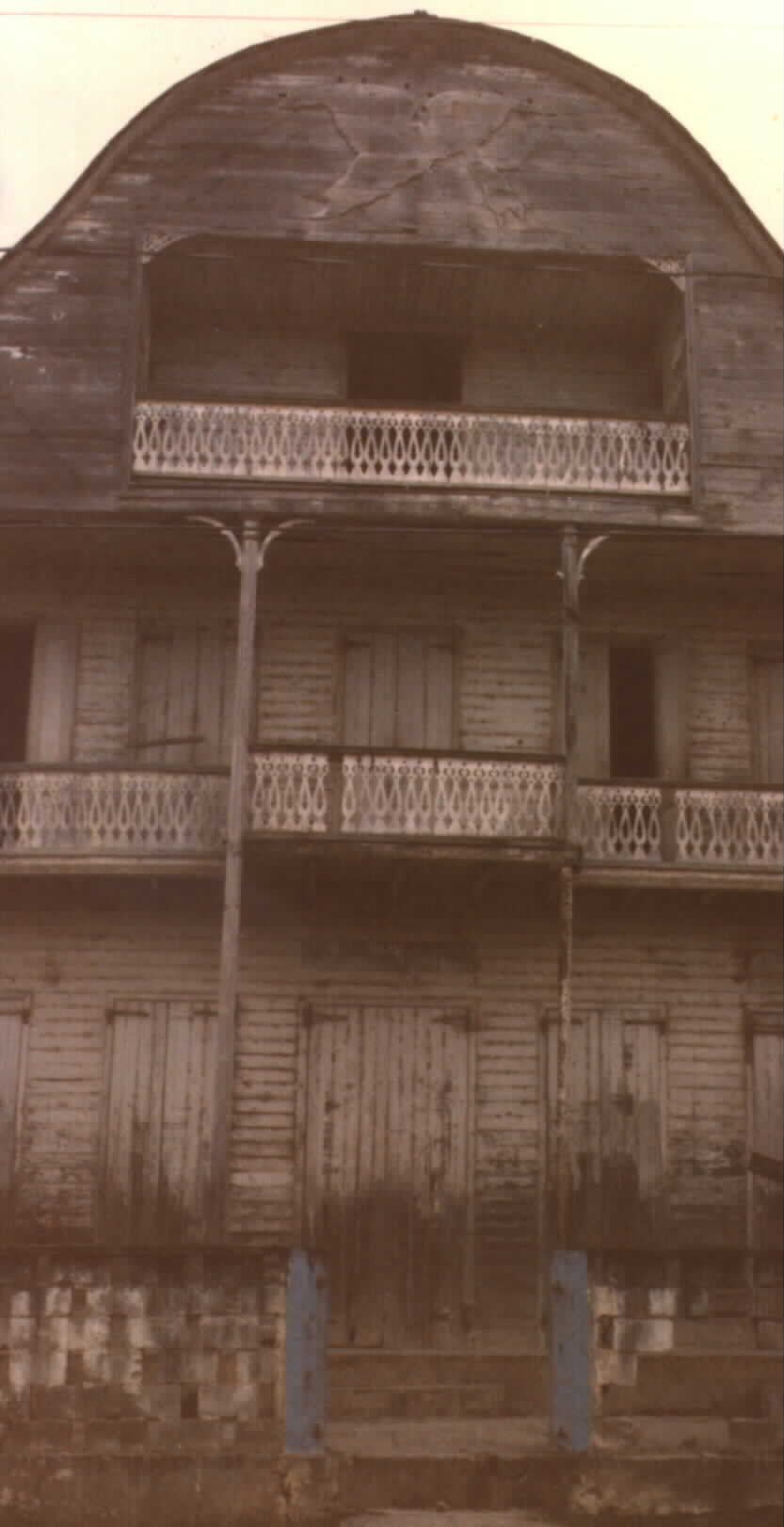



Click here to view: MORE PICTURES OF PORT-DE-PAIX
Click here to view: HAITI's PROCLAMATION OF INDEPENDENCE in 1804
For comments, contact by e-mail HERE:Noe' Dorestant

Documented by Noe Dorestant. All rights reserved 1998.
CLICK HERE TO VIEW ANOTHER "PERSPECTIVE ON HAITI"
